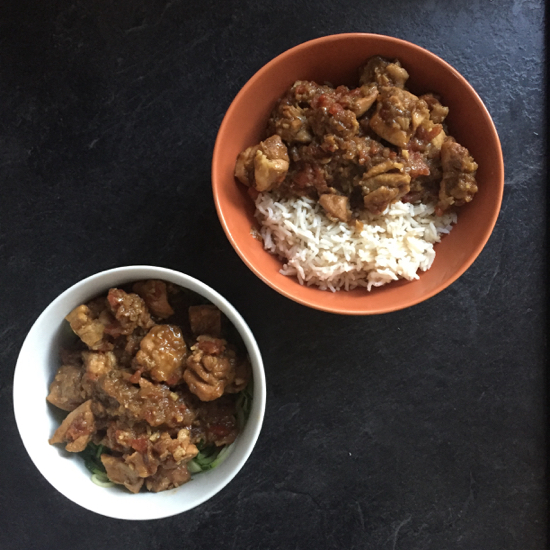
by Jessika Anspach McEliece
It’s funny to look back and remember what you were up to a year ago…
This time last year my husband and I were in the chaotic process of preparing for a very big move. Having retired from a 12-year career with the Pacific Northwest Ballet, we were saying goodbye to Seattle and hello to Winchester, England for a study abroad. And as Seattleites, we thought we’d be saying goodbye to a lot more than just our careers, friends and families…
The home of not only Starbucks or fish-tossing in Pike’s Place Market, Seattle has become quite a culinary crib, with artisan coffee shops and foodie-approved restaurants filling every borough. It’s also a cultural melting pot with a vast array of peoples and ethnicities, all sharing their traditions through the foods they cook. Needless to say we’d become spoiled by farm-to-table meals at hipster haunts or the fast, delicious and accessible Thai take-out that had become a post-performance dinner staple. There’s nothing like a big bowl of spaghetti squash and Green Curry…
And with every conversation we had regarding our impending British transplant, hearing people sarcastically say, “England? I hear the food’s great there…” we prepared our taste-buds and tummies for a year of bland and blah. Thankfully we’ve discovered the stereotype’s all wrong. From the perfect pour-over to lovely latte-art; from buttery pork belly to fish and chips that are a revelation, we’ve struggled to have anything bad here. Seattle doesn’t feel so far away after all…
But there is one culinary custom that’s taken us quite by surprise… Curry.
As quintessentially English as a Sunday Roast, the Brits take their curry very seriously. And it’s seriously good, with so many different varieties I’d never even heard of, let alone tasted. But the most astonishing part is that many make this meal at home. And it actually tastes like a curry from a proper Indian restaurant—take-away not required!
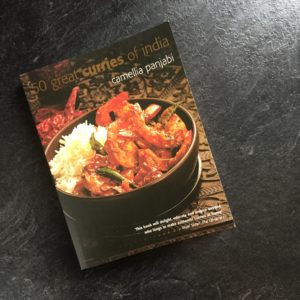 Our neighbor Bill shared with us the secret: Camelia Panjabi’s 50 great curries of India. And from the grease and dried food splatters on nearly every page of his well-loved copy it’s clear that there’s not a bad recipe in this book. A truth we ourselves can attest to.
Our neighbor Bill shared with us the secret: Camelia Panjabi’s 50 great curries of India. And from the grease and dried food splatters on nearly every page of his well-loved copy it’s clear that there’s not a bad recipe in this book. A truth we ourselves can attest to.
Another reason to love curry, aside from it being incredibly delicious, is that it’s loaded with powerhouse ingredients, from healthy fats found in coconut oil and ghee, to Ayurvedic and anti-inflammatory herbs and spices that are the flavorful backbone of nearly every recipe. Perfect food for those tired legs and swollen feet.
And you’d be surprised how accessible and easy the recipes are… Practically all of the ingredients and spices I already had in my pantry (and use regularly) or can be found at the grocery store, ethnic market, or on Amazon.
So without further adieu here’s our slightly adapted version (it’s milder – my husband Ryan can’t tolerate heat) of Camelia’s recipe for a basic, no-frills, ALL FLAVOR, curry.
Simple Homestyle Curry
(Serves 2)
Ingredients
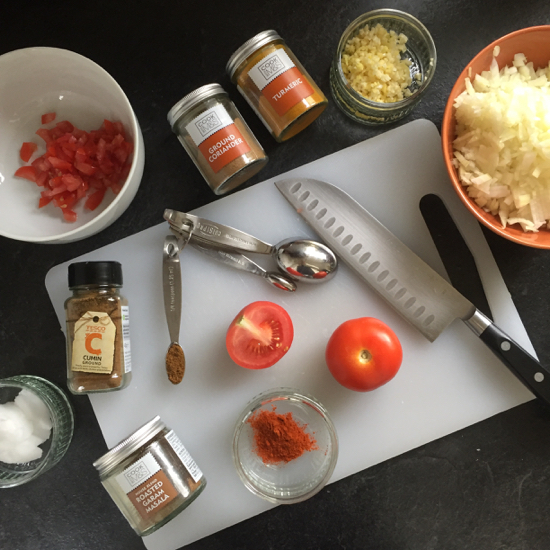
4T coconut oil or ghee
1 large (or 2 small) yellow onion, finely diced
2 garlic cloves, minced
1.5” raw ginger root, peeled and minced
3/4t ground coriander
1/2t* paprika powder
1/4t ground cumin
1/4t** garam masala powder
2 tomatoes, chopped
sea salt
Protein of choice, cubed—we went with boneless, skinless chicken thighs but you can do anything from mixed veggies, to lamb, to fish if you wish.
*The original recipe called for 1 teaspoon of paprika. We actually used 1/2 teaspoon of this special red chili powder Bill gave us because we don’t have paprika. At 1/2 teaspoon there’s a tiny kick. You know your own heat index so use personal discretion…
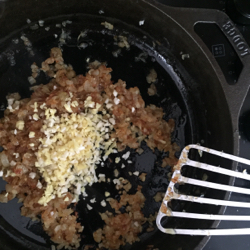 **Garam Masala powder is an amazing mixture of typical Indian spices. If you can’t find it in the supermarket you can blend your own in a spice blender/coffee grinder or find it online or in an Indian/Asian market. Either way this spice is worth having on hand! Great on eggs, avocados, and pretty much everything!
**Garam Masala powder is an amazing mixture of typical Indian spices. If you can’t find it in the supermarket you can blend your own in a spice blender/coffee grinder or find it online or in an Indian/Asian market. Either way this spice is worth having on hand! Great on eggs, avocados, and pretty much everything!
Note: The key to any great curry is to truly caramelize the onions. This takes a HOT pan, steady, moderate heat, and time. The temptation is to speed this up (risking burning the delicate little onions), but I promise you it’s worth the wait.
Also if for some reason the curry is too hot (spicy) for you or your guests having a bit of plain Greek yogurt (or non-dairy equivalent) on hand is a lifesaver!
Directions:
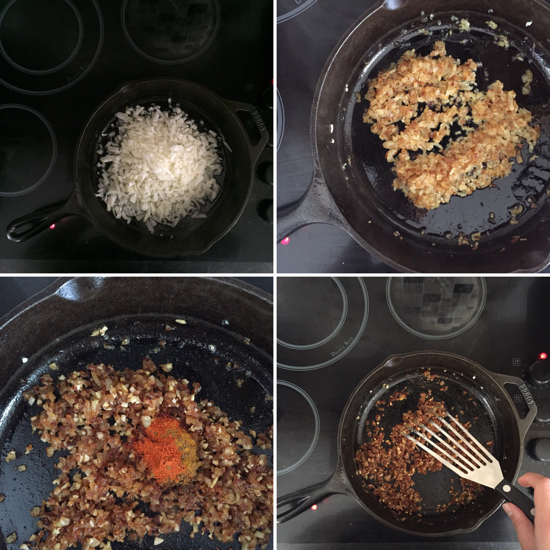
Heat the oil in a heavy bottomed pan or pot over medium heat. Once the oil is sizzling, add the onions, sautéing till deep brown but not burnt, about 20-25 minutes.
Add the minced garlic and ginger, sautéing for 1 minute and then add the ground coriander sautéing another full minute more. Throw in the remaining spices and after thoroughly mixing (about 30 seconds) add 1 cup of water. Set a timer and let it simmer for 10 minutes.
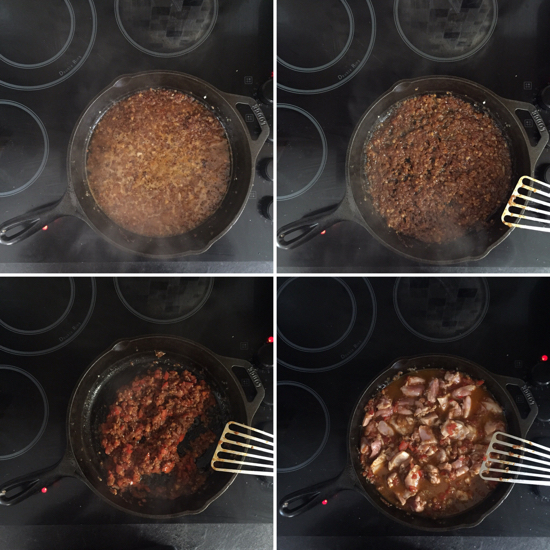
After 10 minutes (the water will have mostly evaporated) add the chopped tomatoes, give it all a good toss and cook another 5 minutes.
NOW season to taste with a bit of sea salt, add your meat and about a cup of water, give or take, depending on what type of protein or veg you use – lamb takes longer to cook so it’ll need more water… Let it simmer and cook down until your meat is cooked through and the sauce is to your desired consistency.
Serve with basmati rice, or for a lower carb/extra veg option go with cauliflower rice or spiraled zucchini pasta.

Contributor Jessika Anspach McEliece, a native of Bellevue, Washington, began her ballet training at the Pacific Northwest Ballet School under the direction of Francia Russell. She progressed through all levels of the school, beginning with Creative Movement, and was invited to be a part of PNBS’s Professional Division program where she was privileged to perform frequently with the Pacific Northwest Ballet. She also attended summer intensive programs at the San Francisco Ballet School, the National Ballet School of Canada and Exploring Ballet with Suzanne Farrell.
She danced for the Suzanne Farrell Ballet Company in 2002 as an apprentice. And in 2004, her dream came true when she was invited by Kent Stowell and Francia Russell to join Pacific Northwest Ballet as an apprentice, promoted the following year to corps de ballet under current director Peter Boal.
Over her 12-year career, she was blessed to dance leading and featured roles in such ballets as Kent Stowell’s Cinderella, Nutcracker and Swan Lake, George Balanchine’s Agon, A Midsummer Night’s Dream, Coppelia, Diamonds, Divertimento from “Baiser de la Fee,” and Symphony in C, Nacho Duato’s Rassemblement, Ulysses’ Dove’s Vespers, Jiri Kylian’s Sechs Tanza (Six Dances), Marco Goecke’s Place a Chill, William Forsythe’s One Flat Thing Reproduced, Benjamin Millepied’s 3 Movements, Mark Morris’s Kammermusik No. 3, Susan Stroman’s TAKE FIVE…More or Less, Ronald Hynd’s The Sleeping Beauty and Andrew Bartee’s Arms that Work.
But what she delighted in most was her role as a senior corps woman, upholding the integrity and caliber of the company with every performance, be it as a villager, a flower or a swan. “As a principal or soloist you maybe get a few shows, but in the corps I got to be in every show. Being on stage is what I worked so hard for. It’s the sprinkles on the sundae. And I got a lot of sprinkles.”
Now retired from her ballet career, Jessika is a freelance writer, having written featured articles for Dance Magazine. Along with contributing to 4dancers and PNB’s blog, she also keeps her own, justJessika, chronicling her life’s adventures, pursuits and passions: travel, faith and of course ballet.




